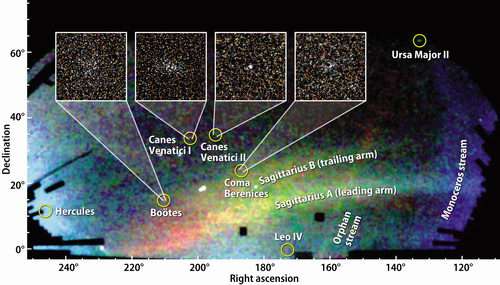Researchers from the Sloan Digital Sky Survey (SDSS-II) announced the discovery of eight new dwarf galaxies, seven of them satellites orbiting the Milky Way. They objects resemble systems cannibalized by the Milky Way billions of years ago to build up its stellar halo and thick disk, characterized as "crumbs from the galactic feast." The systems discovered by the SDSS-II in the last three years are comparable in number to all the Milky Way satellites detected in the preceding 70 years. They help close the gap between the observed number of dwarf satellites and theoretical predictions. Credit: Vasily Belokurov, SDSS-II Collaboration and reproduced by permission, copyright 2007, Astronomy magazine, Kalmbach Publishing Co.
An international team of scientists has discovered seven -- and perhaps eight -- dwarf galaxies orbiting Earth's home galaxy, the Milky Way.
The discovery will be announced today, 9 January 2007, during a press conference at the American Astronomical Society's meeting in Seattle, Washington. The galaxies were discovered as part of the Sloan Digital Sky Survey (SDSS-II), the most ambitious survey of the sky ever undertaken.
"These dwarf galaxies have been captured by the gravity of the Milky Way and most eventually will merge with our own galaxy," explains Penn State Professor of Astronomy and Astrophysics Donald Schneider, a coauthor of the investigation. "The discovery of these dwarf galaxies demonstrates the unexpected power of large astronomical surveys like the Sloan Digital Sky Survey, which originally was designed to investigate objects millions and billions of light years from Earth, not to discover faint companions of our own galaxy." Schneider is the Chairman of the Sloan Digital Sky Survey (SDSS) Quasar Science Group and the SDSS Scientific Publications Coordinator.
According to Daniel Zucker of Cambridge University in the United Kingdom, one of the research team's leaders, theories predict that there should be tens to hundreds more dwarf galaxies yet to be discovered in the "Local Group" of galaxies, which includes the Milky Way. "In less than a year, we have used SDSS-II data to find seven new Milky Way dwarf satellites," Zucker says. "We've just discovered an eighth new dwarf, but we're not yet sure this one is a Milky Way satellite." The SDSS team has found almost as many new Milky Way satellites as were detected in the previous 70 years. Only a handful were known before the SDSS-II survey.
Dwarf galaxies contain, at most, a few million stars. The new dwarfs have some unusual properties. "They're more like Hobbits than dwarfs," comments Zucker's co-investigator Vasily Belokurov, also of Cambridge, "since they are smaller and fainter than most previously known satellites. Several of the newly discovered systems appear to be on the verge of disruption -- probably by the tidal gravity of the Milky Way -- and the 'Ursa Major II' dwarf already seems to be in several pieces. "They look as though they're being ground up," notes Belokurov. Other lead members of the discovery team include Mark Wilkinson, Mike Fellhauer, and Gerry Gilmore of Cambridge University, and Jelte De Jong and Hans-Walter Rix of the Max Planck Institute for Astronomy.
Current theories of galaxy assembly suggest that many -- perhaps all -- of the stars in the halo and thick disk of the Milky Way originated in smaller dwarf galaxies, which were dissolved when they merged into the Milky Way itself. "The new dwarfs are really just the crumbs from the galactic feast," says Zucker. "Most of the merging happened early on -- billions of years ago -- and what we're seeing here are the leftovers."
The SDSS-II is a unique resource for finding Milky Way satellites because its deep, multi-color imaging allows detection of much fainter systems than previously were visible. The new objects are found using sophisticated computer algorithms that troll the digital data to find groupings of related stars. Because the SDSS-II covers only a fifth of the sky, astronomers expect that there are many more undiscovered dwarf galaxies in the universe.
The seven new Milky Way satellites all lie in the area of sky surveyed by the SDSS-II around the North Galactic Pole. There are two new dwarfs in the constellation of Canes Venatici (the Hunting Dogs), one in Bootes (the Herdsman), one in Leo (the Lion), one in Coma Berenices (Bernice's Hair), one in Ursa Major (the Great Bear) and one in Hercules.
The eighth and newest discovery may be the most intriguing. Named Leo T, it is about 1.4-million light years away, on the fringes of the Milky Way's gravitational influence. "It may be a 'free-floating' Local Group dwarf, rather than a satellite of the Milky Way," notes team member Sergey Koposov, of the Max Planck Institute for Astronomy in Heidelberg. In addition to its greater distance, Leo T is distinct from the previous seven discoveries in that it has both populations of fairly old stars (greater than five billion years old) and comparatively young populations (less that one billion years old). It also appears to have neutral hydrogen gas -- an indication that its star-forming days may not be over.
Leo T could be the bellwether of a large population of faint galaxies that reside in the Local Group but are not closely associated with either the Milky Way or the Andromeda galaxy. Because it is too distant to be strongly influenced by the tidal force of the Milky Way, Leo T's low luminosity (the equivalent of roughly 50,000 Suns) is likely intrinsic, not a consequence of the tidal stripping of loosely bound stars. "Leo T probably has always been very faint, retaining its gas and slowly forming stars in relative isolation," comments Mike Irwin, a discovery-team member and Cambridge University astronomer.
In addition, the large number of new dwarfs -- in combination with previously discovered systems from the SDSS-II and other sky surveys -- changes the complexion of the cold-dark-matter theory's "missing satellite" problem. "These discoveries bring the data and the theory closer together," comments Zucker, though there may still be a gap between them.
Source: Penn State
























